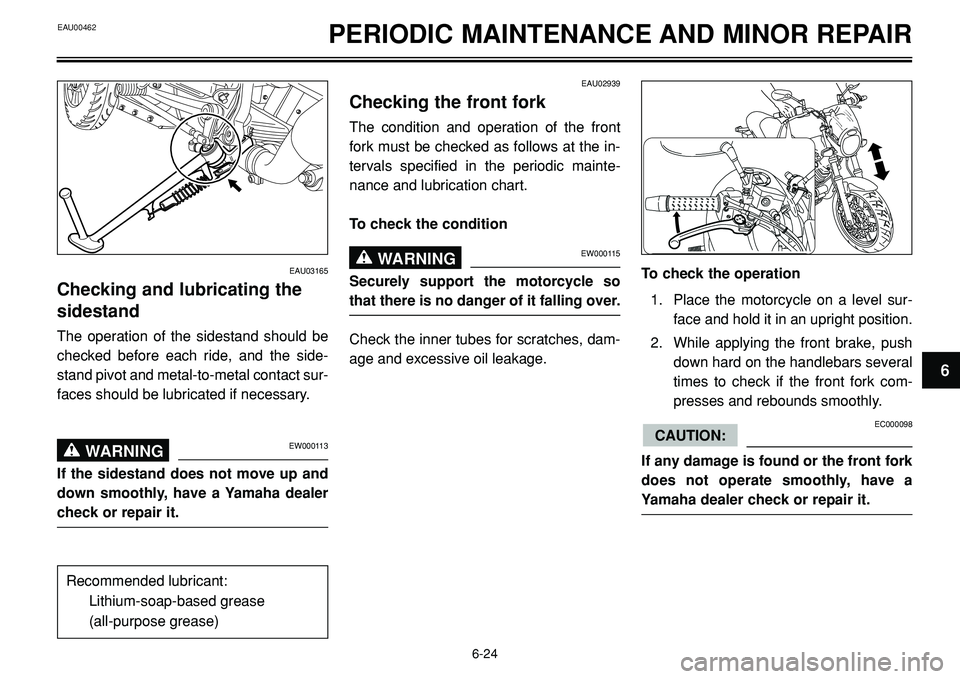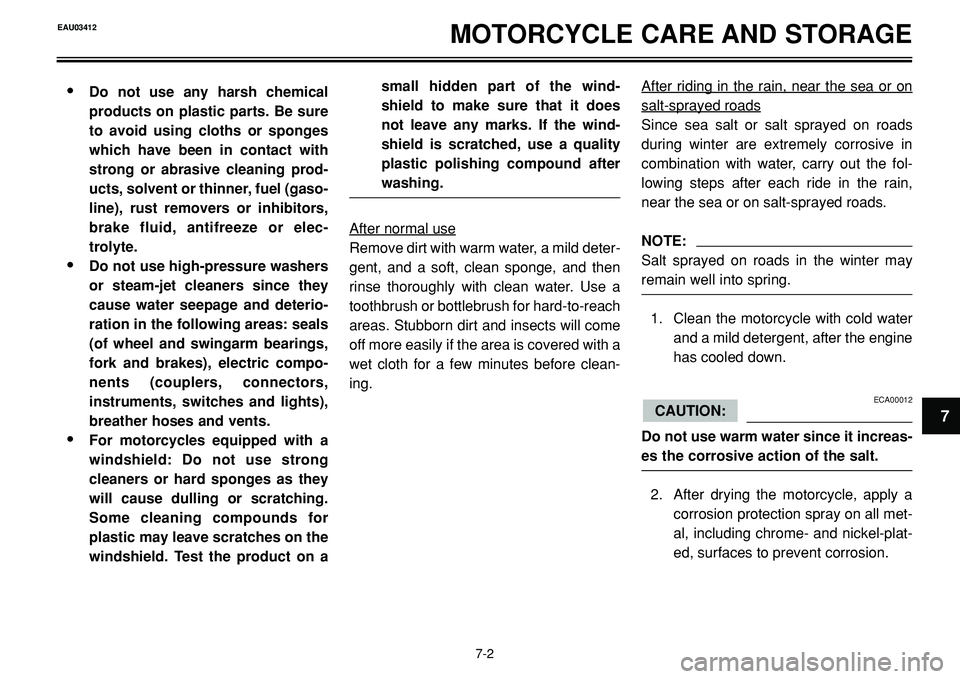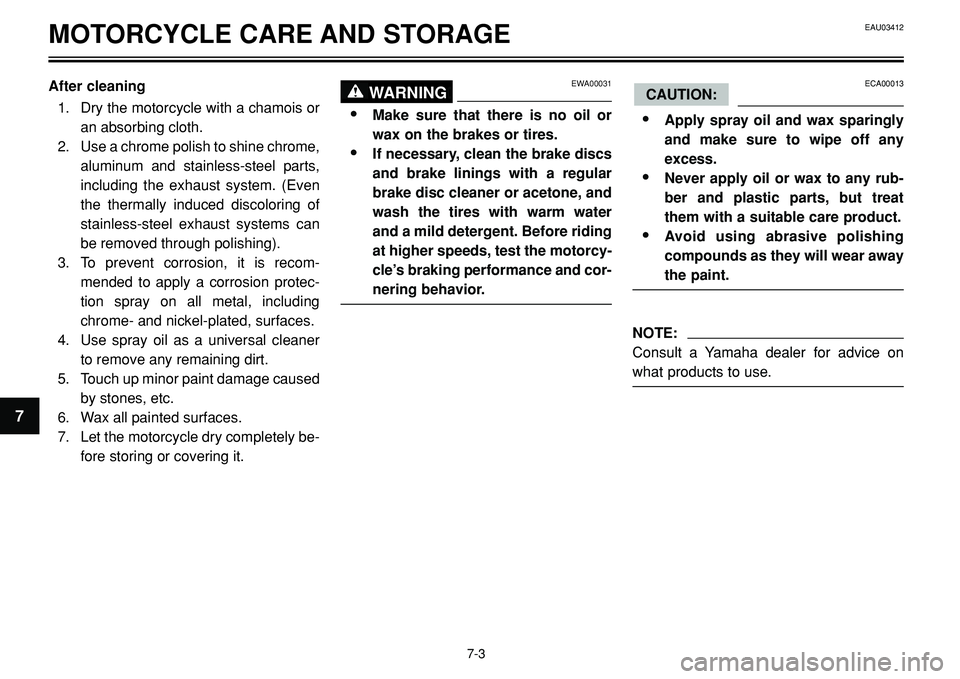Page 66 of 96

EAU00462PERIODIC MAINTENANCE AND MINOR REPAIR
EAU02939
Checking the front fork
The condition and operation of the front
fork must be checked as follows at the in-
tervals specified in the periodic mainte-
nance and lubrication chart.
To check the condition
EW000115WARNING0
Securely support the motorcycle so
that there is no danger of it falling over.
Check the inner tubes for scratches, dam-
age and excessive oil leakage.
To check the operation
1. Place the motorcycle on a level sur-
face and hold it in an upright position.
2. While applying the front brake, push
down hard on the handlebars several
times to check if the front fork com-
presses and rebounds smoothly.
EC000098
If any damage is found or the front fork
does not operate smoothly, have a
Yamaha dealer check or repair it.
CAUTION:
6-24
6
EAU03165
Checking and lubricating the
sidestand
The operation of the sidestand should be
checked before each ride, and the side-
stand pivot and metal-to-metal contact sur-
faces should be lubricated if necessary.
EW000113WARNING0
If the sidestand does not move up and
down smoothly, have a Yamaha dealer
check or repair it.
Recommended lubricant:
Lithium-soap-based grease
(all-purpose grease)
Page 73 of 96

EAU00462
1. Screw
2. Turn signal light len
PERIODIC MAINTENANCE AND MINOR REPAIR
1
2
1. Screw (x 2)
11
NOTE:
Before installing the headlight, be sure to
hook the headlight and auxiliary light bulb
leads into the guide to the left of the head-
light as shown.
12. Have a Yamaha dealer adjust the
headlight beam if necessary.
EAU03497
Replacing a turn signal light
bulb
1. Remove the turn signal light lens by
removing the screw.
2. Remove the defective bulb by push-
ing it in and turning it counterclock-
wise.
3. Insert a new bulb into the socket,
push it in, and then turn it clockwise
until it stops.
4. Install the lens by installing the screw.
EC000065
Do not overtighten the screw, other-
wise the lens may break.
CAUTION:
EAU01623
Replacing the tail/brake light
bulb
1. Remove the tail/brake light lens by re-
moving the screws.
2. Remove the defective bulb by push-
ing it in and turning it counterclock-
wise.
3. Insert a new bulb into the socket,
push it in, and then turn it clockwise
until it stops.
4. Install the lens by installing the
screws.
EC000108
Do not overtighten the screws, other-
wise the lens may break.
CAUTION:
6-31
6
1
1. Leads guide
Page 74 of 96

EAU00462
1. Nut (x 2) 1. Bulb socket
2. Bulb
PERIODIC MAINTENANCE AND MINOR REPAIR
1
1 2
1. Brake caliper (x 2)
2. Wheel axle pinch bolt
3. Wheel axle
4. Spacer (x 2)
�
�
�
�
�
�
EAUB0019
Replacing the license plate
light bulb
1. Remove the license plate light by re-
moving the nuts.
2. Remove the bulb socket from the li-
cense plate light by pulling it out.
3. Remove the defective bulb by pulling
it out.
4. Insert a new bulb into the socket.
5. Install the bulb socket into the license
plate light.
6. Install the license plate light by in-
stalling the nuts.
EAUB0015
Front wheel
To remove the front wheel
EW000122WARNING0
It is advisable to have a Yamaha dealer
service the wheel.
Securely support the motorcycle so
that there is no danger of it falling over.
1. Mark either side of the wheel so that it
can be installed in the original running
direction.
2. Remove the brake calipers by remov-
ing the bolts.
ECA00047
Do not pull the brake lever after the
brake caliper has been removed, other-
wise the brake pads will be forced shut.
3. Loosen the front wheel axle pinch
bolt, then the wheel axle.
4. Pull the wheel axle out together with
the spacers, and then remove the
wheel.
CAUTION:
6-32
6
Page 75 of 96

EAU00462PERIODIC MAINTENANCE AND MINOR REPAIR
EAB00016
To install the front wheel
1. Lift the wheel up between the fork
legs.
2. Install the spacers and insert the
wheel axle.
3. Lower the front wheel so that it is on
the ground.
4. Install the brake calipers by installing
the bolts.
NOTE:
Make sure that there is enough space
between the brake pads before installing
the brake calipers onto the brake discs.5. Tighten the wheel axle, then the front
wheel axle pinch bolt, and the brake
caliper bolts to the specified torques.EAUB0017
Rear wheel
To remove the rear wheel
EW000122WARNING0
It is advisable to have a Yamaha dealer
service the wheel.
Securely support the motorcycle so
that there is no danger of it falling over.
1. Loosen the rear wheel axle pinch
bolt, and then remove the axle nut.
6-33
6
6. Push down hard on the handlebar
several times to check for proper fork
operation. Tightening torques:
Wheel axle:
75 Nm (7.5 m·kgf)
Front wheel axle pinch bolt:
25 Nm (2.5 m·kgf)
Brake caliper bolt:
42 Nm (4.2 m·kgf)
1. Wheel axle pinch bolt
2. Axle nut
3. Brake torque rod bolt
���
Page 76 of 96

EAU00462PERIODIC MAINTENANCE AND MINOR REPAIR
2. Remove the brake torque rod bolt
from the brake caliper bracket, and
then turn the caliper up, away from
the disc.
3. Remove the wheel axle together with
the spacers.
4. Pull the wheel to the right to separate
it from the final gear case, and then
remove it.
ECA00062
Do not push the brake pedal after the
wheel has been removed together with
the brake disc, otherwise the brake
pads will be forced shut.
CAUTION:
EAUB0018
To install the rear wheel
1. Apply a light coating of lithium-soap-
based grease to the splines of the fi-
nal gear case and wheel hub.
2. Install the wheel by inserting the
wheel axle, then installing the axle
nut.
3. Turn the caliper down so that it fits
over the brake disc.
NOTE:
Make sure that there is enough space
between the brake pads before installing
the brake caliper onto the brake disc.
4. Install the wheel axle pinch bolt.
5. Install the brake torque rod bolt at the
brake caliper bracket.6. Install the wheel axle pinch bolt.
7. Lower the rear wheel so that it is on
the ground.
8. Tighten the axle nut, wheel axle pinch
bolt, and brake torque rod bolt to the
specified torques.
6-34
6
Tightening torques:
Axle nut:
110 Nm (11.0 m·kgf)
Wheel axle pinch bolt:
22 Nm (2.2 m·kgf)
Brake torque rod bolt:
35 Nm (3.5 m·kgf)
Page 81 of 96

MOTORCYCLE CARE AND STORAGE
•Do not use any harsh chemical
products on plastic parts. Be sure
to avoid using cloths or sponges
which have been in contact with
strong or abrasive cleaning prod-
ucts, solvent or thinner, fuel (gaso-
line), rust removers or inhibitors,
brake fluid, antifreeze or elec-
trolyte.
•Do not use high-pressure washers
or steam-jet cleaners since they
cause water seepage and deterio-
ration in the following areas: seals
(of wheel and swingarm bearings,
fork and brakes), electric compo-
nents (couplers, connectors,
instruments, switches and lights),
breather hoses and vents.
•For motorcycles equipped with a
windshield: Do not use strong
cleaners or hard sponges as they
will cause dulling or scratching.
Some cleaning compounds for
plastic may leave scratches on the
windshield. Test the product on asmall hidden part of the wind-
shield to make sure that it does
not leave any marks. If the wind-
shield is scratched, use a quality
plastic polishing compound after
washing.
After normal use
Remove dirt with warm water, a mild deter-
gent, and a soft, clean sponge, and then
rinse thoroughly with clean water. Use a
toothbrush or bottlebrush for hard-to-reach
areas. Stubborn dirt and insects will come
off more easily if the area is covered with a
wet cloth for a few minutes before clean-
ing.After riding in the rain, near the sea or on
salt-sprayed roads
Since sea salt or salt sprayed on roads
during winter are extremely corrosive in
combination with water, carry out the fol-
lowing steps after each ride in the rain,
near the sea or on salt-sprayed roads.
NOTE:
Salt sprayed on roads in the winter may
remain well into spring.
1. Clean the motorcycle with cold water
and a mild detergent, after the engine
has cooled down.
ECA00012
Do not use warm water since it increas-
es the corrosive action of the salt.
2. After drying the motorcycle, apply a
corrosion protection spray on all met-
al, including chrome- and nickel-plat-
ed, surfaces to prevent corrosion.
CAUTION:
EAU03412
7-2
7
Page 82 of 96

MOTORCYCLE CARE AND STORAGE
After cleaning
1. Dry the motorcycle with a chamois or
an absorbing cloth.
2. Use a chrome polish to shine chrome,
aluminum and stainless-steel parts,
including the exhaust system. (Even
the thermally induced discoloring of
stainless-steel exhaust systems can
be removed through polishing).
3. To prevent corrosion, it is recom-
mended to apply a corrosion protec-
tion spray on all metal, including
chrome- and nickel-plated, surfaces.
4. Use spray oil as a universal cleaner
to remove any remaining dirt.
5. Touch up minor paint damage caused
by stones, etc.
6. Wax all painted surfaces.
7. Let the motorcycle dry completely be-
fore storing or covering it.EWA00031WARNING0
•Make sure that there is no oil or
wax on the brakes or tires.
•If necessary, clean the brake discs
and brake linings with a regular
brake disc cleaner or acetone, and
wash the tires with warm water
and a mild detergent. Before riding
at higher speeds, test the motorcy-
cle’s braking performance and cor-
nering behavior.
ECA00013
•Apply spray oil and wax sparingly
and make sure to wipe off any
excess.
•Never apply oil or wax to any rub-
ber and plastic parts, but treat
them with a suitable care product.
•Avoid using abrasive polishing
compounds as they will wear away
the paint.
NOTE:
Consult a Yamaha dealer for advice on
what products to use.
CAUTION:
7-3
7
EAU03412
Page 88 of 96
SPECIFICATIONS
8-3
8
EAU01038
Tire air pressure
(measured on cold tires)
Up to 90 kg*
Front 230 kPa; 2.30 kg/cm
2; 2.30 bar
Rear 250 kPa; 2.50 kg/cm
2; 2.50 bar
90 kg–maximum*
Front 250 kPa; 2.50 kg/cm
2; 2.50 bar
Rear 270 kPa; 2.70 kg/cm
2; 2.70 bar
* Total weight of rider, passenger, cargo and accessories
Wheels
Front
Type Cast wheel
Size 17 x MT 3.50
Rear
Type Cast wheel
Size 17 x MT 5.50
Brakes
Front:
Type Dual disc brake
Operation Right hand
Fluid DOT 4Rear:
Type Single disc brake
Operation Right foot
Fluid DOT 4
Suspension
Front: Telescopic fork
Rear: Swingarm
(link suspension)
Spring/shock absorber
Front: Coil spring / oil damper
Rear: Coil spring / gas-oil damper,
spring preload adjustable
Wheel travel
Front: 130 mm
Rear: 113 mm
Electrical system
Ignition system Transistorized coil ignition
(digital)
Charging system
Type A.C. magneto
Standard output 14V, 350W at 5,000 r/min